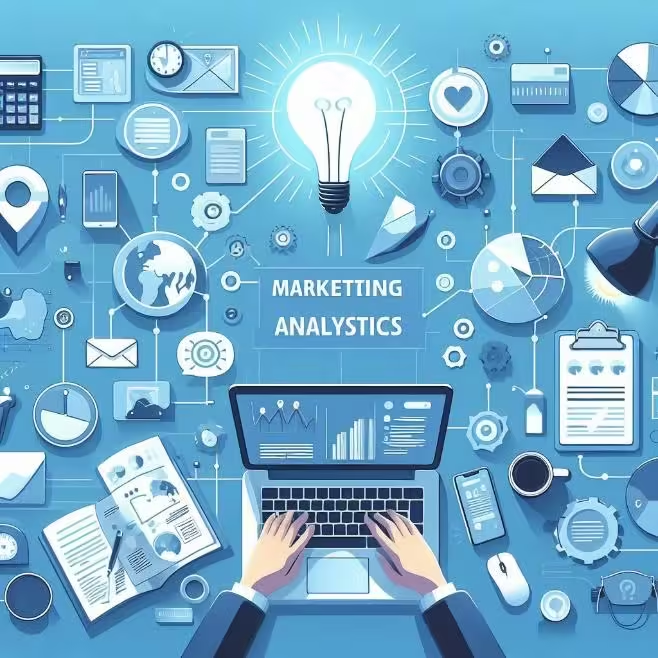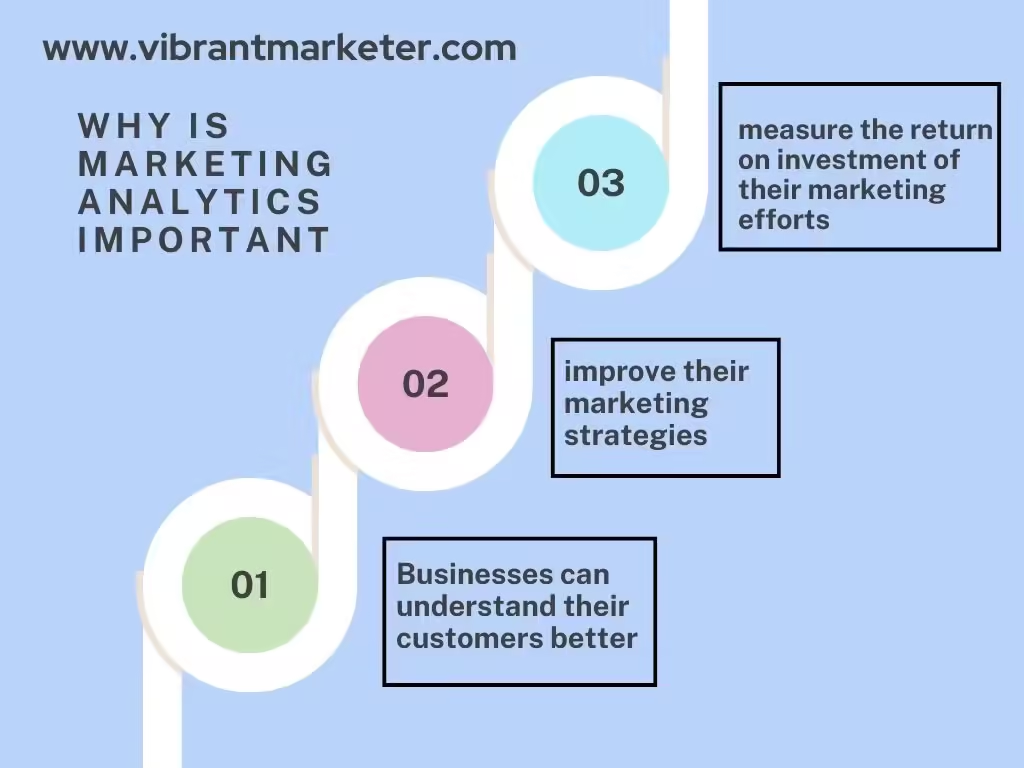
What is Marketing Analytics: Brief Overview with Examples
Table Of Contents
Marketing Analytics: Brief Overview with examples

Marketing analytics is like being a detective for businesses. Imagine you’re trying to figure out why some people like certain toys or snacks, while others don’t. You gather clues—like what colors they like, what shows they watch, or where they shop—and then use those clues to understand their choices. Marketing analytics does something similar but for businesses. It collects and studies clues (data) to help companies understand what customers want and how to make better decisions.
What is Marketing Analytics?

Marketing analytics is the practice of collecting, analyzing, and using data from marketing efforts to help businesses make smarter choices. It’s all about understanding which marketing activities are working (like ads, social media, or emails) and which aren’t. By studying the data points you can improve your marketing strategies, reach more people, and increase sales as well.
According to McKinsey & Company: “Marketing analytics is the practice of measuring, managing, and analyzing marketing performance to maximize effectiveness and optimize return on investment.”
According to Google Analytics: “Marketing analytics helps businesses understand how their marketing activities across various channels impact their revenue and sales by tracking key performance indicators and customer behavior.”
According to McKinsey & Company: “Marketing analytics is the practice of measuring, managing, and analyzing marketing performance to maximize effectiveness and optimize return on investment.”
According to Google Analytics: “Marketing analytics helps businesses understand how their marketing activities across various channels impact their revenue and sales by tracking key performance indicators and customer behavior.”
Where Does Marketing Data Come From?

Marketing data is like a treasure chest of information. But before businesses can use it, they need to gather it. There are three types of data that businesses collect:
- First-Party Data: This is the most important type of data. It comes directly from the people who interact with your business, like visitors on your website or followers on social media. For example, a toy store might track how many kids like to browse superhero toys or watch a specific cartoon. It’s super reliable because it’s collected from real customers.
- Second-Party Data: It is the data, which is shared by another company. Imagine two toy companies sharing information about what kids in different age groups like to play with. It’s useful when businesses have similar audiences.
- Third-Party Data: This data comes from companies that sell or rent information collected from many different sources. While it can provide insights, it’s less reliable because it doesn’t come directly from your customers.
How Businesses Collect First-Party Data
To better understand their customers, businesses use several methods to collect data:
- Surveys: A business might ask its customers simple questions like, “Did you enjoy this product?” or “What could we improve?” For example, a restaurant who is selling pizza could ask their customers what toppings they’d like to see on the menu.
- A/B Testing: This is like a small experiment. For example, if a store wants to know whether red or blue signs will attract more kids, they could show half of their visitors a red sign and the other half a blue sign. Then, they compare how many kids liked each one.
- Tracking Online Behavior: Businesses also pay attention to what people do online—whether they watch a video, read a blog, or click on a link. If a candy store notices that kids love their videos about making chocolate, they might make more of those to attract more visitors.
How Marketing Data is Analyzed
Once businesses have all their data, they need to make sense of it. Here the tools like Google Analytics or SEMRush come in handy. These tools help businesses to organize data as per their need or requirements , like putting puzzle pieces together. After that, businesses can run tests or create graphs to understand trends, patterns, and customer behaviors.
Example: A Toy Company Using Marketing Data
Imagine a toy company wants to know why a new toy is not selling as well as they expected. They gather the datas from their website, social media, and also through surveys. After analyzing the data, they discover that kids prefer a different color of the toy, and the promotional video wasn’t appealing. Based on this, they decide to change the toy’s color and make a funnier video. Sales go up immediately!
Example: A Toy Company Using Marketing Data
Imagine a toy company wants to know why a new toy is not selling as well as they expected. They gather the datas from their website, social media, and also through surveys. After analyzing the data, they discover that kids prefer a different color of the toy, and the promotional video wasn’t appealing. Based on this, they decide to change the toy’s color and make a funnier video. Sales go up immediately!
Why is Marketing Analytics Important?

Marketing analytics is super important because it helps businesses:
- Understand Their Customers: By collecting data, companies can learn what customers like, dislike, and need. This helps businesses create better products or improve their services.
- Improve Marketing Strategies: Marketing analytics can show what type of advertising works best. For example, if social media ads are attracting more customers than email newsletters, a company might invest more in social media.
- Measure ROI (Return on Investment): Businesses want to know if their marketing efforts are worth the money. Marketing analytics helps calculate how much profit each campaign brings in. For example, if a candy company spends $500 on an ad campaign and sells $800 worth of candy because of it, their ROI is 60%.
Case Study - Amazon
Amazon, the giant online store, uses marketing analytics to make sure customers find what they want quickly. When you search for a product on Amazon , They Basically tracks your data like – what you click on, which products you buy, and even what you add to your wishlist. Based on this, they recommend similar items you might like. This personal touch increases customer satisfaction and sales.
Tools Used for Marketing Analytics

There are many tools that businesses use to help them gather and understand data. Here are some popular ones:
- Google Analytics: Track your website traffic and the behavior of your customer.
- MailChimp: Helps businesses analyze how well their email campaigns are doing.
- Sprout Social: This tool Focuses on social media interactions.
- HubSpot: Offers insights on both marketing and sales.
- Datorama: Organizes data from many sources, making it easier for businesses to understand their performance.
How Marketing Analytics Helps Companies Plan for the Future
Marketing analytics is not just about understanding what happened in the past—it’s also about predicting the future. By looking at trends, businesses can figure out what to do next.
For example, if a clothing brand notices that kids love shirts with cartoon characters in summer, they might plan to release more cartoon-themed clothes next summer. This way, they’re always one step ahead of their customers’ needs.
Real-World Example: Coca-Cola’s “Share a Coke” Campaign
Coca-Cola used the marketing analytics to create its one of the most famous “Share a Coke” campaign. By analyzing data, they found out that people love personalization. So, they printed people’s names on Coke bottles. This led to a big increase in sales, because customers loved buying bottles with their names on them to share with friends.
For example, if a clothing brand notices that kids love shirts with cartoon characters in summer, they might plan to release more cartoon-themed clothes next summer. This way, they’re always one step ahead of their customers’ needs.
Real-World Example: Coca-Cola’s “Share a Coke” Campaign
Coca-Cola used the marketing analytics to create its one of the most famous “Share a Coke” campaign. By analyzing data, they found out that people love personalization. So, they printed people’s names on Coke bottles. This led to a big increase in sales, because customers loved buying bottles with their names on them to share with friends.
Challenges of Marketing Analytics

Even though marketing analytics is super useful, it’s not always easy to handle all that data. Some challenges include:
- Too Much Data: Sometimes, businesses collect so much data that it becomes hard to know what’s important and what’s not. It’s like trying to find a specific toy in a huge toy chest.
- Data Quality: Not all data is accurate or useful. Imagine a pizza place getting feedback from only five customers—it may not be enough to make a good decision for everyone.
- Finding the Right People: Not every business has experts who know how to analyze data well. Many companies struggle to find the right “data detectives.”
Guided Activity: Become a Data Detective
Let’s do a fun activity! Imagine you own a toy store. You want to know which toy is more popular: dolls or cars.
- Step 1: Ask your customers (Survey): You ask 10 friends which toy they like more.
- Step 2: Analyze the data: Count how many people chose dolls vs. cars.
- Step 3: Make a decision: If more friends chose cars, you might decide to promote car toys more in your store.
Conclusion: What is Marketing Analytics with Example
Marketing analytics is like having a superpower. It helps businesses understand their customers, improve their marketing strategies, and make smarter decisions. Whether it’s a toy store, pizza place, or a big company like Amazon, marketing analytics is key to staying competitive and growing.
By using marketing data wisely, businesses can create better products, serve their customers better, and ultimately grow faster.
By using marketing data wisely, businesses can create better products, serve their customers better, and ultimately grow faster.
FAQs
KPIs (Key Performance Indicators) are like goalposts that businesses aim for. They help companies see if their marketing is working well. For example, if a business wants to sell 100 toys in a week, their KPI would be reaching that goal.
Marketing analytics helps businesses track which ads people click on the most. If an ad gets a lot of clicks, it means people like it, and the business might use that type of ad more often.
Businesses track purchases to learn what people like. If lots of people buy the same product, the company knows that product is popular and might make more of it or create similar products.
Marketing analytics can show how many people like, comment, or share a company’s posts. This helps businesses understand what content people enjoy and how to get more people interested in their products.
A/B testing is like trying two different things to see which one works better. For example, a business might send two versions of an email to customers, and marketing analytics will tell them which one got more clicks.
Customer reviews give businesses real feedback. They can analyze the reviews to find out what people like and don’t like about their products. This will help them to improve their products and services.
If a business doesn’t use marketing analytics, they might waste money on ads that don’t work, or they might miss out on opportunities to sell more products. Analytics helps businesses stay smart and make better choices.
Companies can track how many people open their emails and click on links. If lots of people are clicking, it shows the email is interesting. If not, they know they need to change their email strategy.
Customer segmentation is like grouping people into different teams based on what they like or need. By doing this, businesses can send the right ads or offers to the right people. Marketing analytics helps figure out which groups exist and what each group prefers.
Yes! Even small businesses can use simple tools like Google Analytics or social media insights to learn more about their customers and grow their business. Marketing analytics isn’t just for big companies; it helps everyone!
Share this post
Recent Posts
